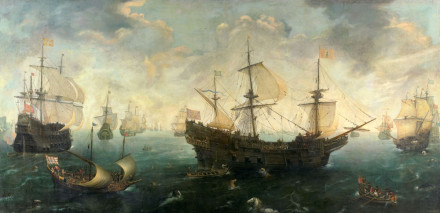History
A wreck from a Spanish Armada
In 1986 a few razor shell fishermen discovered a wreck in the vicinity of Finisterre in Galicia, Spain. The Navy Diving Unit from Ferrol carried out three surveys in 1986 and subsequently archive research was done, by which this wreck was identified as the Capitana de Ivella.
The following year, a group of archaeologists under the direction of Dr. Manuel Martín Bueno excavated the site within the framework of the Finisterrae 87 project.

Historical background
The Capitana de Ivella, also called San Jeronimo, was the flagship of general Pedro de Ivella, a naval commander from Slano, in Ragusa, who led a squadron of twelve ships, the so-called Ragusa squadron. This squadron was part of the Armada under the command of captain general Martín de Padilla. The Armada had departed from Lisbon to occupy the port of Brest in France, consisting of about 80 large ships including Spanish, Portuguese, and Mediterranean galleons, northern hulks (urcas), Cantabrian naos, galizabras, and other types of vessels. They were at anchor off Cape Finisterre on the night of October 28th 1596, when they were caught in a violent storm. Written sources reveal that 25 ships, including some large galleons, sank that night off Cape Finisterre and 2,000 men drowned. The Capitana de Ivella was one of them and Pedro de Ivella died in the incident.

Description
| Tonnage | 1200 ton (600 last) |
|---|
Status
After the excavation in 1987, the recovered artifacts were transferred to the Museo do Mar de Galicia in Vigo. Between 2012 and 2015, further research on wrecks from this fleet was done within the framework of the Finisterre Project, a co-operation between the Institute of Nautical Archaeology (INA), Associate Professor Filipe Castro of the Center for Maritime Archaeology and Conservation (CMAC), and the Regional Government of Galicia.
References
- Abilleira Crespo, Yago (2016).
El Galeón San Jerónimo (octubre de 1576) y su polémica excavación.
Revista general de marina, 271 (1).
pp 29-36. - Hormaechea, Cayetano; Rivera, Isidro; Derquí, Manuel (2018).
Los barcos oceánicos del Atlántico ibérico en los siglos XVI y XVII.
Vol II, 378-385. - Tânia Manuel Casimiro et al. (2023).
The “San Giacomo di Galizia” Warship Galleon (1597)—Building Narratives through an Archaeological and Historical Reading of the Ribadeo I Shipwreck.
Heritage 2023 6(2). - Institute of Nautical Archaeology.
Finisterre Project.